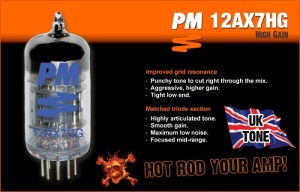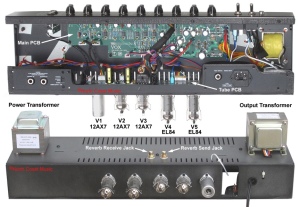Today I’ll be performing a full setup on a Les Paul style guitar.
If your Les Paul seems a little out of whack then follow the guide carefully and together we’ll get her singing again.
Firstly you should tune your guitar to your usual playing preference. I always recommend tuning in playing position whenever possible as tuning the guitar as it lies on its back can often differ.
- 1. Check & adjust neck relief.
A good starting position for any setup is to check the guitars neck relief. Gibson’s recommended method for accomplishing this is to place a capo slightly behind the first fret then press down on the low E (thickest) string just behind the 14th fret with your finger. This allows the relief to be accurately adjusted without any influence from the nut or bridge.
Now, using your free hand, slide a 0.25mm (0.010″) feeler gauge between the low E string and the top of the 9th fret. If you don’t have a feeler gauge then a standard business card works great. If the gap is to high the truss rod needs to be tensioned. If the gap is too low then the truss rod should be loosened. Twist the truss nut clockwise to tighten and counter-clockwise to loosen in quarter turn increments until the gap is perfect.

Once step 1 is complete remove the capo and tune the guitar again.
- 2. Check & adjust string action.
To measure the action of the guitar we will need our feeler gauges again. If you don’t have any feeler gauges then a small mechanics ruler should suffice.
Allow the strings to sit in their natural position and measure the distance between the bottom of both the high and low E strings and the top of the 12th fret. The recommended heights should be as follows;
- Top/High E string (thin) = 1.6mm (4/64″)
- Bottom/Low E String (thick) = 2.4mm (6/64″)
Each side of the bridge has a simple screw adjuster, which when turned, will adjust the height of the E string on the same side. Tightening the adjuster clockwise will lower the string and loosening the adjuster anti-clockwise will raise the string. Make half turns then measure until the action is correct on each of the E strings.
Once finished tune the guitar and take the measurements again to ensure both are still correct. If not repeat until the action is correct whilst perfectly tuned.
- 3. Adjust the string intonation.
If you look at the bridge you will see that each of the strings sits on a small saddle. You will also notice that each saddle has a small adjustment screw which is what is used to control intonation.
Plug your chromatic tuner into your guitar and starting with the low E string ensure that it is perfectly in tune. Now hold down the 12th fret and try again, it should match the open string E note perfectly. If the note is too sharp you will need to lengthen the string by adjusting the saddle towards the bottom of the guitar. If the note is too flat then you will need to shorten the string by adjusting towards the neck. Adjust in half turn increments, re-tuning the open string after each saddle adjustment.
Once the open and 12th fretted notes match perfectly we can move on to the A string. Repeat this process until all strings are completed. Afterwards give each string 2-3 tugs upwards, between the pickups, to ensure everything is seated nicely. Retune again and the intonation will be correct.
- 4. Check for fret buzzing.
Once your guitar has been setup I always like to check for buzzing. This is simply checked by playing each fret, one by one, a string at a time. If you are experiencing fret buzzing after correctly setting the action and neck bow then your next step should be to check for a raised fret using a fret rocker.

If your frets are all perfectly even then the next most common cause of buzzing is a worn or damaged nut. Replacing the nut should hopefully eliminate the problem. The recommended string heights from the first fret should be approximately as follows:
- Low E: 0.030″
- A: 0.030″
- D: 0.022″
- G: 0.022″
- B: 0.015″
- High E: 0.015″
Sometimes nut slots simply need a little lubricant when they are causing issues but if the slots have and broken edges the nut will need replacing. On occasions nut problems can be caused by changing string gauges so ensure that only 1/3 of the string is exposed from the nut and that the other 2/3 is snugly sat inside its slot.
There is a multitude of products available to assist with string buzzing caused by the nut, the most popular of which are graphite powder and Big Bend’s Nut Sauce. Personally whenever changing strings I always rub each slot with a standard sharpened pencil.
- Pickup Height.
This all comes down to personal preference and will also vary depending on the type and brand of your pickups. The closer the pickup pole is to the bottom of the string, the hotter the signal and the lower the pole is away from the string, the cooler the signal. Depending on how hot your pickups are you will want to adjust this to your own liking however it is always best to start with the factory recommended heights and work your way from there by ear.
The pickups are adjusted by loosening and tightening the central screws on either side of the pickup covers. To measure hold your finger down on the guitars last fret and place a small mechanics ruler on the poles to measure its distance from the bottom of the string. Do this on the first and last poles and measure the height for the high and low E strings which should match each other perfectly.
Les Paul’s will normally come pre fitted with stock Humbuckers however, you will also occasionally find models fitted with P90’s. The factory recommended heights are as follows;
- Neck Humbucker: 2.4mm (3/32″)
- Bridge Humbucker: 1.6mm (1/16″)
- Neck P90: 4mm (5/32″)
- Bridge P90: 2.4mm (3/32″)
Note that P90’s are hard to give any specific recommended setting as they are far more sensitive to feedback issues. When adjusting P90’s set them to the above heights as a starting point and fine tune accordingly.

In the world of guitars there are no settings written in stone. It all comes down to personal preference and experience. Getting a feel for your instrument and figuring out what works best is part of each guitarists secret formulae to achieving their “perfect” tone. You will often see some of the greatest tones coming from the most poorly setup, terribly maintained and bashed up guitars you will ever see, but it just works for that player. It’s all about finding the sweet spot between player and guitar that can only be perfected through experience.
If you have any different methods, corrections to my settings or other tips please be sure to leave a comment. I’m always looking to improve upon my own setup.







